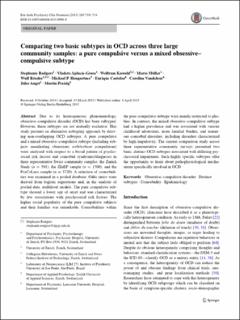Please use this identifier to cite or link to this item:
https://doi.org/10.21256/zhaw-2274| Publication type: | Article in scientific journal |
| Type of review: | Peer review (publication) |
| Title: | Comparing two basic subtypes in OCD across three large community samples : a pure compulsive versus a mixed obsessive-compulsive subtype |
| Authors: | Rodgers, Stephanie Ajdacic-Gross, Vladeta Kawohl, Wolfram Müller, Mario Rössler, Wulf Hengartner, Michael Pascal Castelao, Enrique Vandeleur, Caroline Angst, Jules Preisig, Martin |
| DOI: | 10.1007/s00406-015-0594-0 10.21256/zhaw-2274 |
| Published in: | European Archives of Psychiatry and Clinical Neuroscience |
| Volume(Issue): | 265 |
| Issue: | 8 |
| Page(s): | 719 |
| Pages to: | 734 |
| Issue Date: | Dec-2015 |
| Publisher / Ed. Institution: | Springer |
| ISSN: | 0940-1334 1433-8491 |
| Language: | English |
| Subjects: | Obsessive-compulsive disorder; Distinct subtypes; Comorbidity; Epidemiology |
| Subject (DDC): | 616.8: Neurology, diseases of nervous system |
| Abstract: | Due to its heterogeneous phenomenology, obsessive-compulsive disorder (OCD) has been subtyped. However, these subtypes are not mutually exclusive. This study presents an alternative subtyping approach by deriving non-overlapping OCD subtypes. A pure compulsive and a mixed obsessive-compulsive subtype (including subjects manifesting obsessions with/without compulsions) were analyzed with respect to a broad pattern of psychosocial risk factors and comorbid syndromes/diagnoses in three representative Swiss community samples: the Zurich Study (n = 591), the ZInEP sample (n = 1500), and the PsyCoLaus sample (n = 3720). A selection of comorbidities was examined in a pooled database. Odds ratios were derived from logistic regressions and, in the analysis of pooled data, multilevel models. The pure compulsive subtype showed a lower age of onset and was characterized by few associations with psychosocial risk factors. The higher social popularity of the pure compulsive subjects and their families was remarkable. Comorbidities within the pure compulsive subtype were mainly restricted to phobias. In contrast, the mixed obsessive-compulsive subtype had a higher prevalence and was associated with various childhood adversities, more familial burden, and numerous comorbid disorders, including disorders characterized by high impulsivity. The current comparison study across three representative community surveys presented two basic, distinct OCD subtypes associated with differing psychosocial impairment. Such highly specific subtypes offer the opportunity to learn about pathophysiological mechanisms specifically involved in OCD. |
| Further description: | Erworben im Rahmen der Schweizer Nationallizenzen (http://www.nationallizenzen.ch) |
| URI: | https://digitalcollection.zhaw.ch/handle/11475/2274 |
| Fulltext version: | Published version |
| License (according to publishing contract): | Licence according to publishing contract |
| Departement: | Applied Psychology |
| Organisational Unit: | Psychological Institute (PI) |
| Appears in collections: | Publikationen Angewandte Psychologie |
Files in This Item:
| File | Description | Size | Format | |
|---|---|---|---|---|
| 2015_Rodgers_Comparing-Two-Basic-Subtypes-In-OCD.pdf | 333.32 kB | Adobe PDF |  View/Open |
Show full item record
Rodgers, S., Ajdacic-Gross, V., Kawohl, W., Müller, M., Rössler, W., Hengartner, M. P., Castelao, E., Vandeleur, C., Angst, J., & Preisig, M. (2015). Comparing two basic subtypes in OCD across three large community samples : a pure compulsive versus a mixed obsessive-compulsive subtype. European Archives of Psychiatry and Clinical Neuroscience, 265(8), 719–734. https://doi.org/10.1007/s00406-015-0594-0
Rodgers, S. et al. (2015) ‘Comparing two basic subtypes in OCD across three large community samples : a pure compulsive versus a mixed obsessive-compulsive subtype’, European Archives of Psychiatry and Clinical Neuroscience, 265(8), pp. 719–734. Available at: https://doi.org/10.1007/s00406-015-0594-0.
S. Rodgers et al., “Comparing two basic subtypes in OCD across three large community samples : a pure compulsive versus a mixed obsessive-compulsive subtype,” European Archives of Psychiatry and Clinical Neuroscience, vol. 265, no. 8, pp. 719–734, Dec. 2015, doi: 10.1007/s00406-015-0594-0.
RODGERS, Stephanie, Vladeta AJDACIC-GROSS, Wolfram KAWOHL, Mario MÜLLER, Wulf RÖSSLER, Michael Pascal HENGARTNER, Enrique CASTELAO, Caroline VANDELEUR, Jules ANGST und Martin PREISIG, 2015. Comparing two basic subtypes in OCD across three large community samples : a pure compulsive versus a mixed obsessive-compulsive subtype. European Archives of Psychiatry and Clinical Neuroscience. Dezember 2015. Bd. 265, Nr. 8, S. 719–734. DOI 10.1007/s00406-015-0594-0
Rodgers, Stephanie, Vladeta Ajdacic-Gross, Wolfram Kawohl, Mario Müller, Wulf Rössler, Michael Pascal Hengartner, Enrique Castelao, Caroline Vandeleur, Jules Angst, and Martin Preisig. 2015. “Comparing Two Basic Subtypes in OCD across Three Large Community Samples : A Pure Compulsive versus a Mixed Obsessive-Compulsive Subtype.” European Archives of Psychiatry and Clinical Neuroscience 265 (8): 719–34. https://doi.org/10.1007/s00406-015-0594-0.
Rodgers, Stephanie, et al. “Comparing Two Basic Subtypes in OCD across Three Large Community Samples : A Pure Compulsive versus a Mixed Obsessive-Compulsive Subtype.” European Archives of Psychiatry and Clinical Neuroscience, vol. 265, no. 8, Dec. 2015, pp. 719–34, https://doi.org/10.1007/s00406-015-0594-0.
Items in DSpace are protected by copyright, with all rights reserved, unless otherwise indicated.